![]()
![]()
![]()
Use LEFT and RIGHT arrow keys to navigate between flashcards;
Use UP and DOWN arrow keys to flip the card;
H to show hint;
A reads text to speech;
41 Cards in this Set
- Front
- Back
- 3rd side (hint)
|
Organ systems and their function |
1. Integumentary - protect the body against injury, dehydration, temperature regulation, and against microorganisms *(skin, hair, nails, glands) 2. Skeletal - Protect and support the body/organs *(axial and appendicular) 3. Muscular - Movement, posture, and heat production. *(Muscular, cardiac, smooth) 4. Nervous - Rapidly sends out information via nerve pulses from one part of the body to the other. *(CNS, PNS, ganglia [nerve cells], afferent, efferent, somatic, autonomic, sympathetic, parasympathetic) 5. Endocrine - Sends out information slowly by secreting chemicals from glands. *(Glands - P H P T P T A P G) 6. Circulatory - Transports nutrients and oxygen to tissues, carries waste products away from tissues, carries hormones from the endocrine glands to targeted tissues, temperature regulation and fluid balance, protects the body from bacteria and foreign substances. *(Vessels & heart) 7. Lymphatic - Carries fluid away from tissues. Maintain fluid balance in tissues, absorb fats and other substances from the digestive tract, act as part of the body's immune defense system. *(Lymph, lymph nodes, tonsils, spleen, thymus gland) 8. Respiratory - Transport oxygen to individual cells and transport carbon dioxide from the cells into the lungs and out the body. *(Nasopharynx, oropharynx, laryngopharynx, larynx, trachea, bronchial tree, aveoli) 9. Digestive - Provides the body with water, electrolytes, and other nutrients used by cells. *(Mouth, stomach, small/large intestine, gall bladder, pancreas) 10. Urinary - Remove waste products from the blood and maintain body fluid volume and composition. *(Kidneys, ureters, bladder, urethra) 11. Reproductive - Males produce spermatozoa for females oocytes, vice versa. Fertilization, conception, gestation, and birth. *(Male & female reproductive systems) |
|
|
|
Spinal Cord Anatomy |
Cervical - 7 Thoracic - 12 Lumbar - 5 Sacrum - 5 (fused) Coccyx - 4 (fused) 33 bones - C1 is the atlas, C2 is the axis. Intervertebral disks for shock absorption, support body, and friction. |
|
|
|
Anatomy Physiology Pathophysiology |
Anatomy - The study of the body's structures.
Physiology - The study of how the structures work.
Pathophysiology - The study of abnormal functions and diseases of the human body. |
|
|
|
Layers of skin and hair |
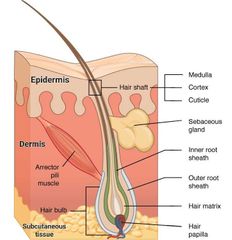
|
|
|
|
Connective tissue types: |
1. Areolar - Attaches to skin and underlying tissue 2. Adipose - Fat 3. Fibrous - Tendons 4. Cartilage - Found on articulating surfaces of bone. Hyaline (ex, trachea), fibro (ex, intervertebral disks) 5. Bone - Ex: Femur 6. Blood - Ex: Vessels 7. Hematopoietic - bone marrow |
Amy ain't feeling cool but benzos help |
|
|
3 major joint types and where they're found. |
Fibrous - Two bones united with fibrous tissue. Little to no movement. (Sutures found in the skull) Cartilaginous - Unite two bones by hyaline cartilage. Allows only slight movement at the joint. (Cartilage rod found between ribs and sternum) Synovial - Contains synovial fluid which is a lubricating film that allows considerable movement between articulating bones. (Joints that unite bones of the appendicular skeleton) |
|
|
|
6 Synovial joint types |
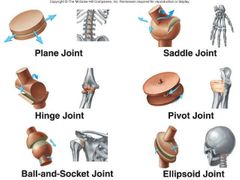
Plane - Two opposed flat surfaces of equal size. (Articular processes between the vertebrae) Saddle - Two saddle shaped articulating surfaces oriented at right angles of each other. Hinge - Convex cylinder in one bone applied to a corresponding concave bone. (Joints of the below and knee.) Pivot - Cylindrical bony processes that rotates within a ring composed of partly bone and partly ligament. (Head of the radius with proximal end of the ulna) Ball-and-socket - Consists of a ball at the end of one bone and socket in adjacent bone. (Shoulder and hip joints) Ellipsoid - Modified ball-and-socket. Surfaces are ellipsoid not spherical. Limits movement similar to hinge joint. (Atlantooccipital: C1 with the base of the skull) |
|
|
|
Muscular contraction |
Muscle fibers are filled with thick and thin myofilaments. Thick myofilaments contain myosin, thin contain actin. The sacromere is the contractile unit of the muscle and contains both myofilaments. A nerve impulse enters the muscle fiber by a motor neuron through the synapse, releasing calcium ions. Calcium ions allow myosin heads on the thin filament to bind to sites on the thick and shorten, and are fueled by ATP. |
|
|
|
Skull bones |
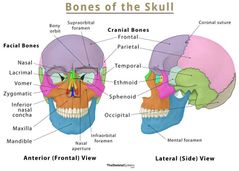
|
|
|
|
Body Movement |
Flexion - bending Extension - straightening out Protraction - Movement in the anterior direction (ex: sticking head forward) Retraction - movement in the posterior direction (ex: pushing head backward) Abduction - movement away from midline (ex: raising arm up from the side) Adduction - movement toward the midline (ex: lowering arm down from the side) Inversion - turning inward (ex: turning foot in) Eversion - turning outward (flexing foot out) Excursion - movement from side to side (jaw side to side) Rotation - movement of a structure around it's axis Circumduction - movement in a circular motion (arm circles) Pronation - rotation of the forearm so that the anterior surface is down (laying face down palm down) Supination - rotation of the forearm so the anterior surface is up (face up palms up) Elevation - Movement of a structure in a superior direction (shrugging shoulders up) Depression - movement of a structure in an inferior direction (shrugging shoulders down) Opposition - movement of the thumb and little finger toward each other (flat hand) Reposition - movement of thumb and little finger away from each other (fingers spread out) |
|
|
|
Branches of nervous system and their functions |

Central nervous system (CNS) - Brain and spinal cord. Peripheral nervous system (PNS) - Nerves and ganglia. Afferent (sensory) division - Transmits action potentials from the organs to the CNS. Efferent (motor) division - Transmits action potentials to the organs/glands from the CNS. Somatic nervous system - Transmits impulses from CNS to skeletal muscles. Autonomic nervous system - Transmits action potentials from the CNS to smooth muscle, cardiac muscle, and certain glands. Sympathetic - Fight or flight. Parasympathetic - Rest & digest. |
|
|
|
Meninges |
Tough, fluid containing membrane that protects the organs of the CNS and is surrounded by bone. 3 layers: Dura mater - superficial & thickest layer. 2 layers around brain and 1 around spine. Arachnoid layer - 2nd layer. Separated from dura mater by a small amount of serous fluid; named subdural space. Pia mater - lies external to a base membrane that envelops the CNS called glia limitans. Space that separates it from arachnoid layer is called subarachnoid space, filled with blood vessels and csf. |
|
|
|
Directional terms |
Superior/cephalic - above another structure. Inferior/caudal - below another structure Proximal - closer to the point of attachment to the trunk Distal - farther from the point of attachment to the trunk. Medial - towards the midline of the body. Lateral - away from the midline of the body. Anterior/ventral - the front of the body. Posterior/dorsal - the back of the body. |
|
|
|
Cranial nerves |
1. Olfactory - smell 2. Optic - vision 3. Occulomotor - eye/pupil movement 4. Trochlear - eye movement 5. Trigeminal - sensations of face, scalp, and teeth. Chewing. 6. Abducens - turning eyes outward. 7. Facial - taste, facial expressions. 8. Vestibulochlear - hearing, balance 9. Glossopharyngeal - sensation of throat, taste, swallowing movement, secretion of saliva. 10. Vagus - sensation of throat, larnyx, thoracic, abdominal organs. Swallowing, voice production, decrease hr, acceleration of peristalsis. 11. Accessory - shoulder movement, turning head. 12. Hypoglossal - tongue movement.
|
Oh, oh, oh, to touch and feel very good vagina. Ah, heaven. |
|
|
Cardiac impulse system |
SA node ➡️ AV node ➡️ bundle of His ➡️ Purkinje fibers. Sinoatrial (SA) node ➡️ impulse spreads through both atria causing contraction ➡️ impulse reaches Atrioventricular (AV) node ➡️ relayed down the bundle of His to Purkinje fibers ➡️ ventricles contract. |
|
|
|
Circulatory anatomy |
Blood enters arteries from the Aorta ➡️ smaller arteries ➡️ aterioles ➡️ capillaries ➡️ venules ➡️ veins ➡️ vena cavas |
|
|
|
Pulmonary anatomy |
Superior & inferior vena cava ➡️ right atrium ➡️ tricuspid valve ➡️ right ventricle ➡️ pulmonary valve ➡️ pulmonary artery ➡️ capillaries in lungs ➡️ pulmonary vein ➡️ left atrium ➡️ bicuspid valve ➡️ left ventricle ➡️ aortic valve ➡️ aorta |
|
|
|
Isotonic/hypertonic/hypotonic |
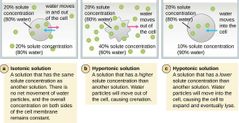
Hypertonic solution: higher solute concentration than inside the cell. (Causes cell to dehydrate, shrink, and die) Isotonic solution: solution has the same solute and water concentration as inside the cell. Hypotonic solution: lower solute concentration than inside the cell (osmotic pressure draws water into the cell, causing it to swell and burst) |
|
|
|
Parietal/visceral membranes |
Serous membranes that line & lubricate pleural spaces. Thoracic: Parietal pericardium - serous layer lines the wall of the pericardium. Visceral pericardium - serous layer lines the wall of the wall of the heart. Between two layers is serous fluid is lubrication for friction. Parietal pleura - outside serous layer on chest wall. Visceral pleura - serous layer on lungs. Serous fluid in-between layers to protect lungs on inspiration. Abdominal: Parietal peritoneum - lines the abdominal and pelvic cavity. Visceral peritoneum - wraps around abdominal organs (stomach, liver, spleen, parts of small and large intestine). |
|
|
|
Renin-angiotensin-aldosterone mechanic |
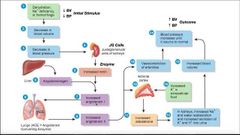
1. Kidneys sense blood pressure drop and releases renin (enzyme). 2. Liver releases angiotensin in response to renin. 3. Renin and angiotensin form to form Angiotensin I. 4. Angiotensin I is converted to Angiotensin II by ACE (angiotensin-converting enzyme) from the lungs. 5. Angiotensin II is a vasoconstrictor. Also stimulates the adrenal cortex to release aldosterone. 6. Stimulates posterior pituitary to secrete ADH. 7. Increases BP.
|
|
|
|
Dehydration vs overhydration (3 types ) |
Dehydration - water lost exceeds the water gained, water deficit occurs. Overhydration - water gained exceeds the water lost, water excess occurs. Types of dehydration: Isotonic: excess loss of sodium and water in equal amounts. Hypernatremic: loss of more water than sodium. Hyponatremic: loss of more sodium than water. |
|
|
|
Magnesium storage/function (Mg+) (bivalent cation like calcium) |
Activates many enzymes. Magnesium is excreted by the kidneys. Distributed: 40-60% insoluable state in muscle & bone, 30% in cells, 1% in serum. Hypomagnesemia - abnormally low magnesium in blood. *Alcoholism, diabetic ketoacidosis, starvation, etc*Causes: nausea/vomiting, tremors, increased reflexes, cardiac dysrhythmias (prolonged QT intervals may lead to cardiac arrest), confusion Hypermagnesemia - abnormally high magnesium in the blood. *Rare, chronic renal insufficiency*Causes: sedation, confusion, muscle weakness, respiratory paralysis, cardiac dysrhythmias |
|
|
|
4 tissue types |
1. Epithelial - covers or forms structures derived from body surfaces. (Skin) 2. Connective - most abundant and distributed tissue. Consists of cells separated from each other by extracellular matrix. (7 types) 3. Muscle - contractile tissue and behind all body movement. (Skeletal, cardiac, smooth [digestive, urinary, reproductive]) 4. Nervous - ability to conduct an electrical signal known as action potential. (Neurons [conducting cells] and neuroglia [support cells of brain, spine, and peripheral nerves]) |
|
|
|
Muscle contraction |
Isometric - tension increases, length stays the same. (Important for posture) Isotonic - tension remains the same, length decreases. (Movement) |
|
|
|
Perfusion/hypoperfusion/obstacles |
Hypoperfusion - decreased circulation of blood and nutrients to tissues and organs. Result of decreased cardiac output. |
|
|
|
Types of shock |
Hypovolemic - caused by hemorrhage or severe dehydration. Circulating volume is lost. Cardiogenic - hearts pumping action cannot deliver adequate circulation for tissue perfusion despite an adequate amount of blood volume (arrhythmias) Neurogenic - spinal cord injury & loss of sympathetic vasomotor tone. Obstructive - obstruction of blood flow into and out of the heart (cardiac tamponade, tension pneumo) Distributive - system vascular resistance drops, leading to leakage of intravascular volume (severe inflammation like anaphylaxis or sepsis) |
|
|
|
MODS |
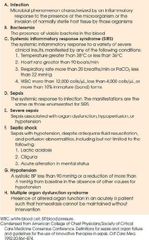
Multiple organ dysfunction syndrome. Progressive failure of two or more organ systems following an acute threat. (Any process that triggers inflammation [trauma, sepsis, burns may initiate mods]) |
|
|
|
Aerobic vs anaerobic metabolism |
Anaerobic - metabolic need for energy exceeds the oxygen supply. Generates 2 ATP molecules for every molecule of glucose. Under cellular hypoxia (state of shock) glucose is metabolized to lactate and pyruvate. This produces 2 ATP molecules. Rate of glycolysis must be greatly increased to meet the body's energy demands. Leads to increase of lactic acid and metabolic acidosis.
Aerobic - body produces energy with oxygen. 36 ATP molecules for every molecule of glucose. Glucose is metabolized into lactate and pyruvate, pyruvate enters the Krebs cycle because oxygen is present. |
|
|
|
Blood types |
Type A - blood as A antigens. Plasma has B antibodies. Type B - blood has B antigens, plasma has B antibodies Type AB - blood has A&B antigens, no antibodies in plasma. Type O - blood has no antigens, plasma has A&B antibodies Positive blood has Rh protein. Negative blood has Rh antibodies. |
|
|
|
Local and systemic response |
Local - vasodilation, increased vascular permeability, and formation of exudate. Systemic - fever, leukocytosis, increase in circulating plasma proteins. |
|
|
|
Hypersensitivity |
Immediate or delayed. Delayed are byproducts of cell immunity. IgE reactions - immunoglobulin E accounts for less than 1% of antibodies in normal serum. Responsible for immediate hypersensitivity reactions. |
|
|
|
Primary vs acquired immunity |
Primary - hereditary. Acquired - exposed to substance: - nutritional deficiencies -Iatrogenic deficiencies (caused by form of medical treatment) -trauma (bacterial infection, burns) -stress (depressed immune function -AIDS |
|
|
|
Psychoneuroimmunology |
Study of three way interaction of the emotional state, central nervous system, and body's defense against external infection and abnormal cell division. |
|
|
|
Catecholamines |
Stimulate two major class receptors: alpha-adrenergic receptors and veta-adrenergic receptors. (Alpha-1, Alpha-2, Beta-1, Beta-2)
Alpha-1: postsynaptic. Located on effector muscles (blood vessels, skeletal muscle) stimulates the contraction of smooth muscle. Alpha-2: Found on presynaptic nerve endings. Inhibits further release of norepinephrine. Beta-1: located in heart. Beta-2: located in the brionchioles and arterial smooth muscle. Betas dilate bronchioles and blood vessels in skeletal muscle, brain, and heart. Aid in glycogenolysis.
*Epi activates alpha and beta receptors. Norepi mainly excites alpha receptors*
|
|
|
|
Cortisol |
Circulates in the plasma and mobilizes substances that are needed for cellular metabolism. Enhances elevation of blood glucose by reducing glucose utilization. Acts as immunosuppressant: reduces production of lymphocytes. *Stress event and length of exposure determine if it's adaptive or destructive |
|
|
|
Age characteristics |
Neonate: birth to 1 month. Infant: 1 month to 1 year. Toddler: 1-2 years. Preschool: 3-5 years School age: 6-12 years Adolescents 13-18 Early adulthood: 19-20 Middle adult: 41-60 Late adult: 61-75 Advanced: 75+ |
|
|
|
Reflex & baby reflexes |
Reflex: automatic response to stimuli without conscious thought. Babinski - great toe bends upward when the outer edge of the sole is stroked. Palmar grasp- infant curls the fingers in response to a touch on the palm of the hand. Rooting: touch side of baby's cheek/mouth causing baby to turn it's head to the side touched. Sucking: touching the infants lips causes involuntary sucking movement. Moro: loud noise near infant, infant stretches arms&legs, spreads fingers, then hugs itself. Stepping: examiner holds infant upright with feet touching solid surface, infant makes stepping movements. Tonic neck: infant in supine position, infant turns the head and extends arms&legs to the side the heads turned to. |
|
|
|
Neonate & infant vital signs. |
Neonate: 100-200 hr, 40-60RR born, drops to 30-40 after delivery. Systolic bp-70, 98-100°F. 7-8lbs. Head is 25% body weight. Gain 5-6 ounces of weight a week. Sleep 16-18 hours a day until 4 months. Fast metabolism.
Infant: 120hr, 25RR, systolic bp-90. Weight will be tripled from birth. Makes major advanced in physical and mental skills. Anterior frontanel closes at 9-18 months. Starting to walk. |
|
|
|
Temperament |
Characterization of a person's behavior defined by how the person interacts with the environment. Reciprocal solization - early socializations are the child's interactions with others and their environment. |
|
|
|
Toddlers & preschooler vital signs |
Toddler: 98-140 hr, 20-37RR, bp 106/86
Preschooler: 80-120hr 20-37RR, systolic bp 112/89. |
|
|
|
School age (6-12 y.o) |
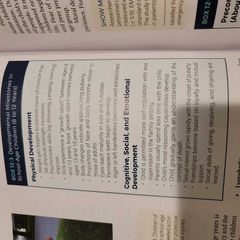
Vital signs: 70-120 hr, 15-20 RR, bp systolic 80-110
95% of the skull growth is complete by 10. Self-concept and self esteem. Could be reaching puberty. |
|

